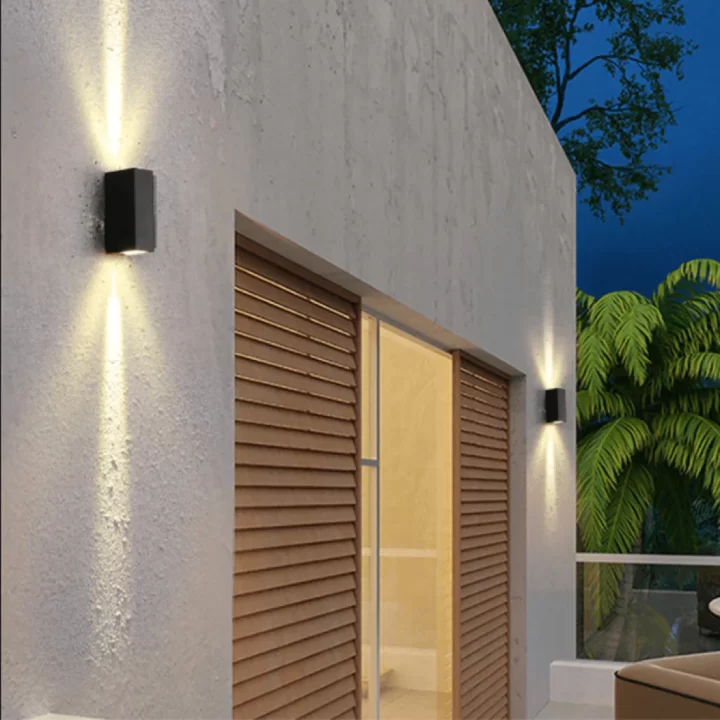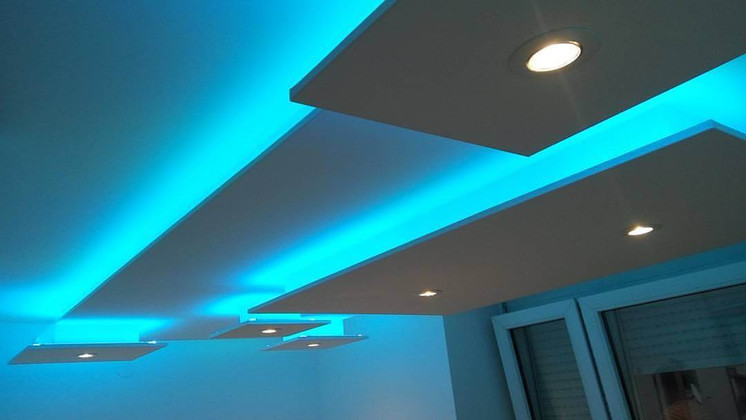Do You Put LED Lights On The Ceiling Or Wall?

In recent years, LED lights have become a popular choice for lighting in both homes and businesses. LED lights have several advantages over other types of lighting, including lower energy consumption, longer life spans, and cooler operating temperatures. LED lights are available in various colors and width sizes and can be used for various purposes.
Two main ways to install LED lights are on the ceiling or the wall. Both options have pros and cons, so it is important to consider all the factors before making a final decision.
Do you put LED lights on the ceiling or wall?
LED lights can go either way; both have pros and cons for lighting on walls & ceilings. So first, you need to decide the location and purpose of installing the LED lights.
Choosing a Location for LED Lights
Ceiling LED lights can illuminate a room without taking up too much space. LED ceiling lights are often used in living rooms, bedrooms, and hallways, where the light must be spread evenly throughout the space. LED lights on the ceiling can also provide a more focused light source for tasks such as reading or studying. LED ceiling lights are usually installed in recessed fixtures, which helps to reduce the amount of glare and provides a more uniform light output.
On the other hand, LED wall lights provide more direct lighting for specific tasks or areas. LED wall lights are often used as accent lighting to highlight a room’s artwork, sculptures, or other features. LED wall lights can also provide more focused task lighting in office or work areas and are often used to illuminate cabinets, shelves, closets, and other storage areas. LED wall lights are generally installed on a surface such as a wall or ceiling and direct the light downward onto the desired area.
When deciding between LED ceiling lights and LED wall lights, it is important to consider the size of the space, the type of light needed, and the overall aesthetic desired. LED lights are a great way to add style and ambiance to any room, so choosing a solution that will work best for your needs is important.
Pros Of Putting LED Strip Lights On The Wall

There are several benefits of sticking LED lights on the wall.
Can provide Task or Accent Lighting
LED wall lights are ideal for task or accent lighting in specific areas. LED wall lights can illuminate a room’s artwork, sculptures, cabinets, shelves, and other features. LED wall lights also provide more direct light than LED ceiling lights, making them perfect for focused tasks such as reading or studying.
It can be Easily Positioned.
LED wall lights are easy to adjust and move around as needed. This makes them ideal for areas where you may need to frequently adjust the position of the light, such as in an office or work area—allowing you to direct the light exactly where it is needed.
It can be used to highlight Wall Art or Decorative Element.
LED wall lights provide a more focused light source that can draw attention to specific design elements, making the entire space look more visually appealing. LED wall lights also highlight a room’s artwork, sculptures, and other features.
Cons Of Putting LED Strip Lights On The Wall
Low Brightness
They are typically not as bright as LED ceiling fixtures, so better options for areas needing higher lighting may exist.
Pros Of Putting LED Strip Lights On The Ceiling

Installing LED strip lights on the ceiling can provide plenty of illumination, making them great for large areas or workspaces. LED lighting on the ceiling is less likely to cast glare and shadows than on the wall, so it’s ideal for maintaining a consistent, even light.
Some of the pros of having LED lights on the ceiling are:
Can Create a More Spacious Feeling
LED ceiling lights can provide a more spacious feeling by creating an even ambient light that fills the entire room. LED lights on the ceiling also help to reduce shadows, giving the illusion of more space.
It can be Easily Positioned.
LED ceiling lights are easy to adjust and move around as needed. This makes them ideal for areas where you may need to frequently adjust the position of the light, such as in a living room or bedroom. LED ceiling lights are also easy to install and can be mounted directly onto the ceiling with minimal effort.
Provides Ambient Lighting
LED ceiling lights are perfect for providing a soft, ambient light that fills the entire room.
Can highlight architectural features
LED ceiling lights can also highlight architectural features such as beams, arches, and other decorative elements in a room. LED ceiling lights provide a more focused light source that can help draw attention to specific design elements.
Cons Of Putting LED Strip Lights On The Ceiling
LED strip lights on the ceiling can be tricky to install, as you may need to make holes in the wall or ceiling for wiring and mounting.
May Not Look Good If You Have Low Ceilings
LED strip lights on the ceiling may not look good in rooms with low ceilings, as the LED strip lights are quite large and bulky.
Not As Flexible As LED Wall Lights
Although LED strip lights on the ceiling can provide plenty of illumination for a room, they are less adjustable or flexible than LED wall lights. You may be unable to move LED strip lights on the ceiling when needed, so LED wall lights may be a better option if you want more control over your lighting.
Conclusion
When choosing LED lights, it is important to consider the size of the space, the type of light needed and the overall aesthetic desired. LED ceiling lights and LED wall lights offer unique benefits that can help create a more inviting atmosphere in any room. LED ceiling lights are great for soft ambient lighting, while LED wall lights provide task or accent lighting, making them perfect for highlighting artwork and other decorative elements. LED lights are a great way to add style and ambiance to any space.
In conclusion, the decision on whether to install LED lights on the ceiling or the wall hinges significantly on both the functional needs and aesthetic preferences of the space being illuminated. Ceiling-mounted LED lights are typically used to provide general lighting across an entire room. This placement allows for a wide distribution of light, making it ideal for primary light sources in living rooms, kitchens, and bedrooms. The elevation of the ceiling placement helps avoid direct glare, making it comfortable for everyday activities, and it can make rooms feel larger and more open.
Alternatively, wall-mounted LED lights offer more specialized lighting solutions that can enhance the ambiance or highlight specific features of a room. For instance, wall-mounted LEDs are perfect for creating accent lighting, which can draw attention to artwork, bookshelves, or architectural details. They can also provide excellent task lighting in spaces like bathrooms and kitchens, where work needs to be performed at close quarters. Furthermore, the choice between wall and ceiling installation might depend on the existing decor and the desired dramatic effect. Wall lights can add layers to a room’s lighting scheme, creating a warm and inviting atmosphere with shadows and highlights, whereas ceiling lights provide uniformity and functionality. Ultimately, the best approach often involves a combination of both, allowing the strengths of each placement to complement the other, thereby creating a well-rounded and effective lighting environment.






